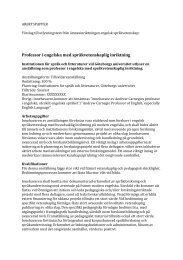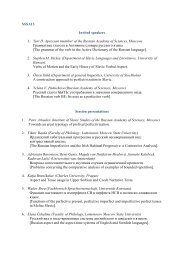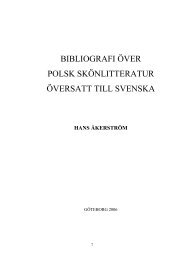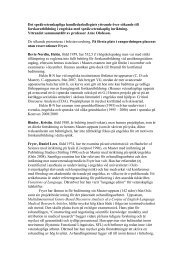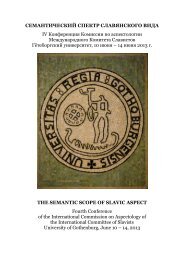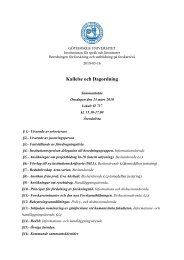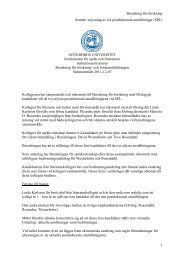PRELUDEIn 2003, an original artistic project entitled “Correspondence” was conceived and performedin Tokyo that, in retrospect, seems to offer some stimulating insights into issues of culturaltranslation. 1 Correspondence was a modest original opera, for which I collaborated with Belgianavant-garde artist Dr. Eric van Hove 2 as co-producer and co-director. For this experimentalproject, van Hove wrote the words to be spoken and sung, and designed images to be displayed,while I created music to accompany the performance with both vocalists and a chamber orchestra.Our work was supplemented by both semi-improvisatory sounds from renowned electronicdance musician Kenji Williams 3 and masterful movement from butoh dancer Kinya “Zulu”Tsuruyama. 4 Correspondence was quite a low-budget project since most performers were stillstudents, including the Japanese orchestra members, singers, and other participants, and whatis relevant to this essay is not so much the novelty (or nostalgia) of our work, nor its artisticcontribution, which admittedly may have been regarded as rather insignificant in the judgmentof some audience members. Rather, I would like to begin with a brief consideration of what wasexpressed through this artistic performance regarding attempts to bridge cultural differences,particularly via “translation” in the discourses of music and language.The principal unifying theme of Correspondence was reflected in multiple layers within itstitle. This work was about the angular meeting of lines and planes, including the attempt to understandhow ideas in one domain (e.g. Japanese society, language and art) may be expressedin another (e.g. European societies, languages and music), while it was also literally based on aseries of letters, or correspondence between van Hove in Japan and his acquaintances abroad towhom he was writing about his initial observations of life in contemporary Japan. We offered aspecial sneak preview of selections from the opera at a school for disabled children in WesternTokyo, whose administration assured us we were the first group of foreigners ever to visit. Thatwas a deeply touching experience, since we sensed that the performance in some way meant asmuch to these Japanese children, with their broad range of mental and physical struggles, as itcould ever mean to an audience of healthy and educated adults. 5 They too seemed to struggle tounderstand and be understood, and perhaps also feared causing offense that could lead to rejectionin what seemed to us to be a society deeply invested in perfection. Of course, van Hove and Iwere still only beginning to understand Japanese society at the time, and had much to learn.I suppose there is inevitably something somewhat megalomaniacal about any attempt toembark on an original artistic project of this kind, yet van Hove and I felt at the time that it wasalso courageous and somehow necessary. If we did not strive to create some great new performanceart to express our impressions of contemporary Japan, we mused, who would? Since the1 Correspondence website, http://www.transcri.be/correspondence.html2 Eric van Hove official website, http://transcri.be3 Kenji Williams website, http://www.kenjiwilliams.com/4 Zulu page, Codice Bianco website, http://www.codice-bianco.it/it/progetto_12_2007/zulu.html5 For recent research on music therapy interventions, see Brynjulf Stige, Gary Ansdell, Cochavit Elefant,and Mercédès Pavlicevic, Where Music Helps: Community Music Therapy in Action and Reflection (Aldershot:Ashgate, 2010), and Brynjulf Stige, Culture-Centered Music Therapy (New Braunfels, TX: BarcelonaPublishers, 2002).<strong>Cultural</strong> translation and Music21
time of Correspondence, I have focused more on academic scholarship, often at the expense ofneglecting my artistic side, 6 while van Hove has completed an MA degree in shodo (Japanese calligraphy)from Tokyo Gakugei University and a PhD in contemporary art from Tokyo Universityof Fine Arts, and given exhibitions and performances in numerous countries around the world.Dr. van Hove is perhaps most well-known as a poet and avant-garde calligrapher nowadays, withprojects that involve drawing improvised poetry in unusual modes and locations worldwide,such as in public squares, underwater, across sands in the desert, in the arctic snow, and in Africain collaboration with various wild animals, and his best known work is probably the provocativeMetragram series that entails images of calligraphy being drawn on the abdomens of an assortmentof women in around 50 locations all across the world. 7Dr. van Hove’s poetry, which I turned into song, expressed many intriguing images associatedwith the challenge of attempting to reach an understanding of an entirely different foreignculture and its language. In “Correspondence”, van Hove wrote “The seams of modern Japan arevisible, and its creators have only celestial reflection of the human condition’s infinite tragedy,daily and unnoticed as the beauty of a pool of water.” I recall that as I strove to develop music forthis intriguing line of poetry, I was struck with how difficult it is to express cross-cultural understandingsmeaningfully without essentializing differences. At the same time, van Hove’s writingswere to some extent about the reflective experience of self-discovery in a foreign context.In another line of Correspondence he wrote, “You know as I do, this discomfort that submergesyou when suddenly you hear yourself: being so far from truth at the very time when you werewalking on a serene path with it as the destination.” I was also deeply impressed by some passagesfrom Correspondence in which van Hove acknowledged the musicality of a language one isstill struggling to comprehend. “Little by little,” van Hove observed that “Japanese makes its significantinroads toward me, from a still hollow significant is birthed the full signifier that I couldonly suspect until now.” Indeed, we may have much to learn about the nature of language andprocess of translation by reflecting on parallel phenomena in music.This essay will explore various ways that intercultural analyses of musical meanings may offertheoretical insights applicable to the broader field of cultural translation. Music, like language,qualifies as a field in which “ideological horizons of homogeneity have been conceptualized,” 8and postcolonialist scholars such as Homi Bhabha and Paul Gilroy have acknowledged its criticalrole as an emblem of identity within the very sites of hybridity that particularly interest scholarsof cultural translation. 9 Nevertheless, it appears that previous studies have not explicitly acknowledgedthe role that music may play in the field of cultural translation, and there is need fortheoretical models to address its relationship to other forms of discourse in this regard.While much has already been theorized regarding how foreign musical genres may be trans-226 Sociomusicology blog (David G. Hebert), http://sociomusicology.blogspot.com7 Metragram Series website, http://cargocollective.com/metragram8 See Boris Buden and Stefan Nowotny, “<strong>Cultural</strong> translation: An introduction to the problem,” TranslationStudies, 2(2), 196-208 (2009); p.206.9 Homi K. Bhabha, The Location of Culture (London: Routledge, 1994), and Paul Gilroy, The Black Atlantic:Modernity and Double Consciousness (London: Verso, 1993).David G. Hebert
- Page 1: Cultural TranslationsProceedings of
- Page 4 and 5: PrefaceThe idea of organizing a wor
- Page 6 and 7: ContentsAcknowledgementIIPrefaceIII
- Page 8 and 9: Literature and Transculturality:Som
- Page 10 and 11: agenda of Herder, which was to figh
- Page 12 and 13: nomenon. However, until long into t
- Page 14 and 15: Tawada’s work appeared in Swedish
- Page 16 and 17: multiple interpretations. Japan is
- Page 18 and 19: Cultural Translation between Tradit
- Page 20 and 21: George P. Murdock illustrated the p
- Page 22 and 23: ancestor of the Maori arrived in Ao
- Page 24 and 25: nal names do not necessarily have.
- Page 26 and 27: One of the functions of ‘cultural
- Page 30 and 31: planted, adopted and fused with ind
- Page 32 and 33: liest known written clues regarding
- Page 34 and 35: since there are many Asians and Pac
- Page 36 and 37: listening to and evaluating sounds
- Page 38 and 39: Ensemble, and the Moscow Pan-Asian
- Page 40 and 41: temporary Finnish folk music. 29I a
- Page 42 and 43: Although some space for improvisati
- Page 44 and 45: whom have devoted many years to ser
- Page 46: POSTLUDEBy way of conclusion, allow
- Page 49 and 50: IntroductionThe aim of this paper i
- Page 51 and 52: to discuss what role Japan was to p
- Page 53 and 54: I may be allowed henceforth to use
- Page 55 and 56: program was to promote and help stu
- Page 57 and 58: 50different of that of Millán -Ast
- Page 59 and 60: most impracticable people in the ea
- Page 61 and 62: intending to give the Book a quasi
- Page 63 and 64: understood by the West on a time wh
- Page 65 and 66: FUJIWARA Masahiko. (2008) Kokka no
- Page 67: - (2002) Cultural light, political
- Page 70 and 71: Translation, or better, linguistic
- Page 72 and 73: one may not expect anything other t
- Page 74 and 75: as Murakami opts for a globalized v
- Page 76 and 77: market. 17 Another indispensable to
- Page 78 and 79:
(This is part of my doctoral thesis
- Page 80 and 81:
elieve advances man’s progress he
- Page 82 and 83:
ender the New Testament into Japane
- Page 84 and 85:
a synonym for kami. The latter is a
- Page 86 and 87:
The American school text is in the
- Page 88 and 89:
Willson Reader 46 T73 47I will not
- Page 90 and 91:
Gentlzer, Edwin & Tymoczko, Maria 2
- Page 92 and 93:
Tea ceremony or tea cult?Translatin
- Page 94 and 95:
Company (VOC), men came from differ
- Page 96 and 97:
H. Stolpe gathered items in Japan f
- Page 98 and 99:
simple presentations had negative i
- Page 100 and 101:
theticism, with its manifold bearin
- Page 102 and 103:
Kumakura, Isao (1980) 近 代 茶
- Page 104 and 105:
1. Introduction and aim of the pape
- Page 106 and 107:
main character and the caller doesn
- Page 108 and 109:
not” and ”at present” that ha
- Page 110 and 111:
match this name, a sea as artificia
- Page 112 and 113:
I John Gabriel BorkmanHenrik Ibsen
- Page 114 and 115:
his dream during the 1870s, when ca
- Page 116 and 117:
make a decision. But it turns out t
- Page 118 and 119:
Ôgai’s change of translation str
- Page 120 and 121:
Behind every utterance lies two mot
- Page 122 and 123:
a large group of persons be gathere
- Page 124 and 125:
The “Territory of Translation”
- Page 126 and 127:
八 十 日 間 世 界 一 周 :
- Page 128 and 129:
heuristic tools, especially conside
- Page 130 and 131:
Left: Photo of Kawashima Chūnosuke
- Page 132 and 133:
Burlington Gardens is in London (Ro
- Page 134 and 135:
門 アリ 入 リテ 見 レバ
- Page 136 and 137:
scene seems to be merely one of man
- Page 138 and 139:
Niwa Jun’ichirō’s Spring Tale
- Page 140 and 141:
The text is full of detailed descri
- Page 142 and 143:
where the narrative voice does not
- Page 144 and 145:
The reason the “territory of tran
- Page 146 and 147:
Translating the Trip Around the Wor
- Page 148 and 149:
ForwordI have been working on my do
- Page 150 and 151:
clining though. By the end of 1980
- Page 152 and 153:
幸 い 神 の 怒 りは 鎮 ま
- Page 154 and 155:
The Public Sphere as Deliberation o
- Page 156 and 157:
and absence of hierarchy would have
- Page 158 and 159:
was used much like we would use “
- Page 160 and 161:
outcasts and bandits - were suppose
- Page 162 and 163:
cal sense, the arena where particip
- Page 164 and 165:
society” and in which “there wa
- Page 166 and 167:
sic formulations, the public sphere
- Page 168 and 169:
はじめに日 本 統 治 下 の
- Page 170 and 171:
似 地 一 下 一 下 拽 那 鼻
- Page 172 and 173:
ということから、 古 丁
- Page 174 and 175:
の「 序 」で、 大 東 亜
- Page 176 and 177:
3.1 翻 訳 と 満 洲 国 語 政
- Page 178 and 179:
取 り 入 れを 主 張 する
- Page 180 and 181:
文 化 の 翻 訳 としての「
- Page 182 and 183:
史 性 にも 留 意 すべきだ
- Page 184 and 185:
て、 渦 巻 きよりほかは
- Page 186 and 187:
変 わらないということも
- Page 188 and 189:
訳 語 と 新 語 から 見 る
- Page 190 and 191:
しは「 無 為 」や「 本 性
- Page 192 and 193:
思 想 を 基 礎 として、
- Page 194 and 195:
って「 物 理 上 哲 学 」
- Page 196 and 197:
し、まさにはこの 時 期
- Page 198 and 199:
意 譯 : 理 學 、 性傅 汛
- Page 200 and 201:
柴 田 昌『 增 補 訂 正 英
- Page 202 and 203:
一 八 七 七 年 、 文 部 省
- Page 204 and 205:
日 中 友 好 の 象 徴 「 鑑
- Page 206 and 207:
と 指 摘 した。成 吉 思
- Page 208 and 209:
をあげている。さらにま
- Page 210 and 211:
に 請 ひて 出 家 を 求 む
- Page 212 and 213:
この 時 奉 請 の 十 師 等
- Page 214 and 215:
歴 史 小 説 『 天 平 の 甍
- Page 216 and 217:
点 」が 生 じたと 指 摘
- Page 218 and 219:
まず、 昨 今 、 活 発 に
- Page 220 and 221:
2、 従 来 の 比 較 文 学 (c
- Page 222 and 223:
普 遍 理 論 を 適 用 し、
- Page 224 and 225:
ス・テグネル(Esaias Tegnér,
- Page 226 and 227:
に 満 ちる「 生 命 」に
- Page 228 and 229:
う 形 をとって 展 開 した
- Page 230:
学 が 大 学 で 展 開 して



